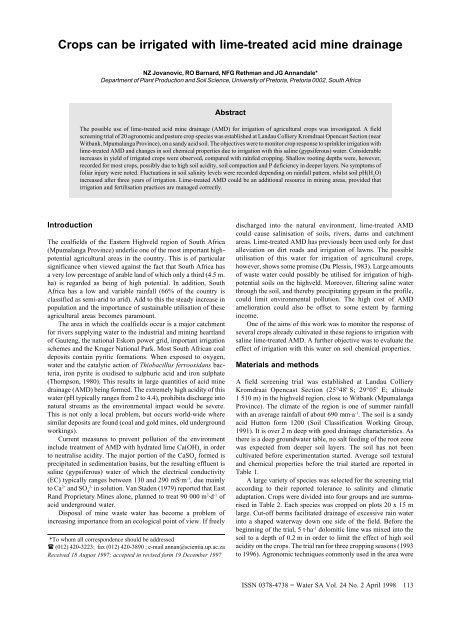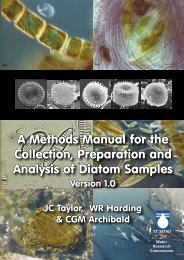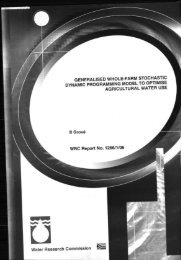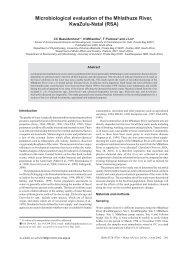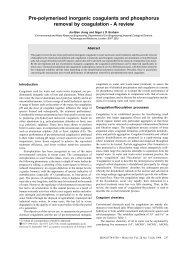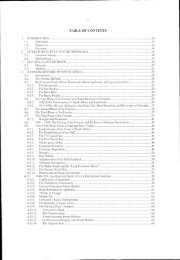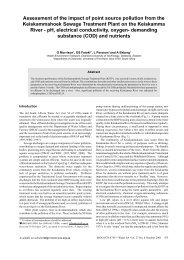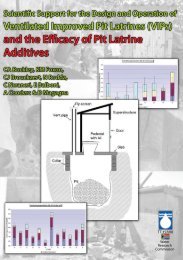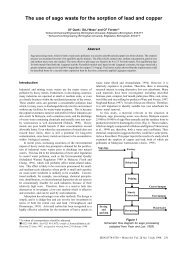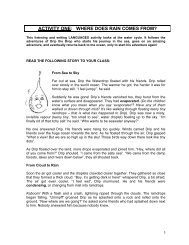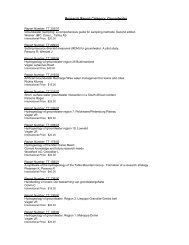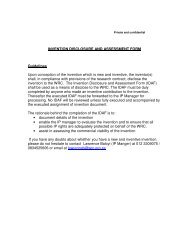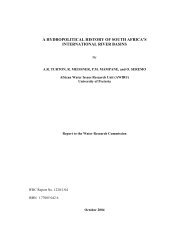Crops can be irrigated with lime-treated acid mine drainage - Water ...
Crops can be irrigated with lime-treated acid mine drainage - Water ...
Crops can be irrigated with lime-treated acid mine drainage - Water ...
Create successful ePaper yourself
Turn your PDF publications into a flip-book with our unique Google optimized e-Paper software.
<strong>Crops</strong> <strong>can</strong> <strong>be</strong> <strong>irrigated</strong> <strong>with</strong> <strong>lime</strong>-<strong>treated</strong> <strong>acid</strong> <strong>mine</strong> <strong>drainage</strong><br />
NZ Jovanovic, RO Barnard, NFG Rethman and JG Annandale*<br />
Department of Plant Production and Soil Science, University of Pretoria, Pretoria 0002, South Africa<br />
Abstract<br />
The possible use of <strong>lime</strong>-<strong>treated</strong> <strong>acid</strong> <strong>mine</strong> <strong>drainage</strong> (AMD) for irrigation of agricultural crops was investigated. A field<br />
screening trial of 20 agronomic and pasture crop species was established at Landau Colliery Kromdraai Opencast Section (near<br />
Witbank, Mpumalanga Province), on a sandy <strong>acid</strong> soil. The objectives were to monitor crop response to sprinkler irrigation <strong>with</strong><br />
<strong>lime</strong>-<strong>treated</strong> AMD and changes in soil chemical properties due to irrigation <strong>with</strong> this saline (gypsiferous) water. Considerable<br />
increases in yield of <strong>irrigated</strong> crops were observed, compared <strong>with</strong> rainfed cropping. Shallow rooting depths were, however,<br />
recorded for most crops, possibly due to high soil <strong>acid</strong>ity, soil compaction and P deficiency in deeper layers. No symptoms of<br />
foliar injury were noted. Fluctuations in soil salinity levels were recorded depending on rainfall pattern, whilst soil pH(H 2<br />
O)<br />
increased after three years of irrigation. Lime-<strong>treated</strong> AMD could <strong>be</strong> an additional resource in mining areas, provided that<br />
irrigation and fertilisation practices are managed correctly.<br />
Introduction<br />
The coalfields of the Eastern Highveld region of South Africa<br />
(Mpumalanga Province) underlie one of the most important highpotential<br />
agricultural areas in the country. This is of particular<br />
signifi<strong>can</strong>ce when viewed against the fact that South Africa has<br />
a very low percentage of arable land of which only a third (4.5 m.<br />
ha) is regarded as <strong>be</strong>ing of high potential. In addition, South<br />
Africa has a low and variable rainfall (66% of the country is<br />
classified as semi-arid to arid). Add to this the steady increase in<br />
population and the importance of sustainable utilisation of these<br />
agricultural areas <strong>be</strong>comes paramount.<br />
The area in which the coalfields occur is a major catchment<br />
for rivers supplying water to the industrial and mining heartland<br />
of Gauteng, the national Eskom power grid, important irrigation<br />
schemes and the Kruger National Park. Most South Afri<strong>can</strong> coal<br />
deposits contain pyritic formations. When exposed to oxygen,<br />
water and the catalytic action of Thiobacillus ferrooxidans bacteria,<br />
iron pyrite is oxidised to sulphuric <strong>acid</strong> and iron sulphate<br />
(Thompson, 1980). This results in large quantities of <strong>acid</strong> <strong>mine</strong><br />
<strong>drainage</strong> (AMD) <strong>be</strong>ing formed. The extremely high <strong>acid</strong>ity of this<br />
water (pH typically ranges from 2 to 4.4), prohibits discharge into<br />
natural streams as the environmental impact would <strong>be</strong> severe.<br />
This is not only a local problem, but occurs world-wide where<br />
similar deposits are found (coal and gold <strong>mine</strong>s, old underground<br />
workings).<br />
Current measures to prevent pollution of the environment<br />
include treatment of AMD <strong>with</strong> hydrated <strong>lime</strong> Ca(OH) 2<br />
in order<br />
to neutralise <strong>acid</strong>ity. The major portion of the CaSO 4<br />
formed is<br />
precipitated in sedimentation basins, but the resulting effluent is<br />
saline (gypsiferous) water of which the electrical conductivity<br />
(EC) typically ranges <strong>be</strong>tween 130 and 290 mS·m -1 , due mainly<br />
to Ca 2+ and SO 4<br />
2-<br />
in solution. Van Staden (1979) reported that East<br />
Rand Proprietary Mines alone, planned to treat 90 000 m 3·d -1 of<br />
<strong>acid</strong> underground water.<br />
Disposal of <strong>mine</strong> waste water has <strong>be</strong>come a problem of<br />
increasing importance from an ecological point of view. If freely<br />
*To whom all correspondence should <strong>be</strong> addressed<br />
( (012) 420-3223; fax (012) 420-3890 ; e-mail annan@scientia.up.ac.za<br />
Received 18 August 1997; accepted in revised form 19 Decem<strong>be</strong>r 1997<br />
discharged into the natural environment, <strong>lime</strong>-<strong>treated</strong> AMD<br />
could cause salinisation of soils, rivers, dams and catchment<br />
areas. Lime-<strong>treated</strong> AMD has previously <strong>be</strong>en used only for dust<br />
alleviation on dirt roads and irrigation of lawns. The possible<br />
utilisation of this water for irrigation of agricultural crops,<br />
however, shows some promise (Du Plessis, 1983). Large amounts<br />
of waste water could possibly <strong>be</strong> utilised for irrigation of highpotential<br />
soils on the highveld. Moreover, filtering saline water<br />
through the soil, and thereby precipitating gypsum in the profile,<br />
could limit environmental pollution. The high cost of AMD<br />
amelioration could also <strong>be</strong> offset to some extent by farming<br />
income.<br />
One of the aims of this work was to monitor the response of<br />
several crops already cultivated in these regions to irrigation <strong>with</strong><br />
saline <strong>lime</strong>-<strong>treated</strong> AMD. A further objective was to evaluate the<br />
effect of irrigation <strong>with</strong> this water on soil chemical properties.<br />
Materials and methods<br />
A field screening trial was established at Landau Colliery<br />
Kromdraai Opencast Section (25°48' S; 29°05' E; altitude<br />
1 510 m) in the highveld region, close to Witbank (Mpumalanga<br />
Province). The climate of the region is one of summer rainfall<br />
<strong>with</strong> an average rainfall of about 690 mm·a -1 . The soil is a sandy<br />
<strong>acid</strong> Hutton form 1200 (Soil Classification Working Group,<br />
1991). It is over 2 m deep <strong>with</strong> good <strong>drainage</strong> characteristics. As<br />
there is a deep groundwater table, no salt feeding of the root zone<br />
was expected from deeper soil layers. The soil has not <strong>be</strong>en<br />
cultivated <strong>be</strong>fore experimentation started. Average soil textural<br />
and chemical properties <strong>be</strong>fore the trial started are reported in<br />
Table 1.<br />
A large variety of species was selected for the screening trial<br />
according to their reported tolerance to salinity and climatic<br />
adaptation. <strong>Crops</strong> were divided into four groups and are summarised<br />
in Table 2. Each species was cropped on plots 20 x 15 m<br />
large. Cut-off <strong>be</strong>rms facilitated <strong>drainage</strong> of excessive rain water<br />
into a shaped waterway down one side of the field. Before the<br />
<strong>be</strong>ginning of the trial, 5 t·ha -1 dolomitic <strong>lime</strong> was mixed into the<br />
soil to a depth of 0.2 m in order to limit the effect of high soil<br />
<strong>acid</strong>ity on the crops. The trial ran for three cropping seasons (1993<br />
to 1996). Agronomic techniques commonly used in the area were<br />
ISSN 0378-4738 = <strong>Water</strong> SA Vol. 24 No. 2 April 1998 113
TABLE 1<br />
AVERAGE SOIL TEXTURAL AND CHEMICAL PROPERTIES AT KROMDRAAI<br />
Property<br />
Soil depth (cm)<br />
0 to 20 20 to 40 40 to 60<br />
Sand coarse 2.0 to 0.5 mm (%) 44.3 36.8 35.1<br />
Sand medium 0.5 to 0.25 mm (%) 28.8 32.5 30.0<br />
Sand fine 0.25 to 0.05 mm (%) 10.2 11.8 12.2<br />
Silt 0.05 to 0.002 mm (%) 4.9 5.3 6.6<br />
Clay < 0.002 mm (%) 11.8 13.6 16.1<br />
pH(H 2<br />
O) 4.45 4.15 4.2<br />
Electrical resistance (ohm) 797 2632 1922<br />
Bray I P (mg·kg -1 ) 32 4 3<br />
Ammonium acetate Ca 233 115 91<br />
extractable cations Mg 10 8 9<br />
(mg·kg -1 ) K 22 19 19<br />
Na 9 8 7<br />
adopted. Details on planting dates, plant populations,<br />
fertilisation, weed control and cultivation practices were<br />
reported by Barnard et al. (1998). The forage crops were<br />
harvested during the growing season <strong>be</strong>fore reaching the<br />
flowering stage.<br />
A stationary line source sprinkler irrigation system<br />
was set up on the experimental field. Each plot was<br />
provided <strong>with</strong> a solenoid valve, and managed on an<br />
individual basis <strong>be</strong>ing <strong>irrigated</strong> <strong>with</strong> three G-Type 2<br />
Hunter sprinklers. The line source irrigation system<br />
allowed differentiation of three water and salt application<br />
treatments: wet, medium and dry. It was not possible<br />
to establish a control treatment <strong>irrigated</strong> <strong>with</strong> good<br />
quality water as <strong>lime</strong>-<strong>treated</strong> AMD is the only source of<br />
water available for irrigation in the area. Soil water<br />
content (SWC) of the wet treatment was maintained<br />
close to field capacity. SWC was measured <strong>with</strong> a<br />
neutron water meter, model CPN 503DR Hydropro<strong>be</strong><br />
(Camp<strong>be</strong>ll Pacific Nuclear, California, USA) [Mention<br />
of manufacturers is for the convenience of the reader only<br />
and implies no endorsement on the part of the authors,<br />
their sponsors or the University of Pretoria]. Soil water<br />
content was measured for each crop and treatment every<br />
3 to 4 d in 0.2 m soil layers down to 1.2 m. Twice weekly,<br />
irrigations were applied to limit soil salinity effects on<br />
plants grown in the wet treatment. In order to increase<br />
irrigation efficiency, no leaching fraction (LF) was applied<br />
to the wet treatment as it was assumed that rainfall<br />
would leach a portion of the salts from the soil profile.<br />
The plots were <strong>irrigated</strong> under low wind conditions,<br />
generally in the late afternoon, in order to avoid water<br />
drift and improve distribution uniformity. Irrigation<br />
amounts (I) and precipitation (P) were measured <strong>with</strong><br />
rain gauges.<br />
Top dry matter (TDM) and harvestable dry matter<br />
(HDM) were measured for each crop and treatment at<br />
TABLE 2<br />
CROP SPECIES SCREENED AT KROMDRAAI LANDAU COLLIERY<br />
Annual subtropical:<br />
Maize (Zea mays cv. SNK 2340)<br />
Soy<strong>be</strong>an<br />
(Glycine max. cv. Ibis)<br />
Sorghum (Sorghum bicolor cv. Pan 888)<br />
Pearl millet (Pennisetum glaucum cv. SA standard)<br />
Cowpeas<br />
(Vigna unguiculata cv. Dr Saunders)<br />
Annual temperate:<br />
Rye (Secale cereale cv. SSR 1)<br />
Oats<br />
(Avena sativa cv. Over<strong>be</strong>rg)<br />
Triticale (Triticum x Secale cv. Cloc 1)<br />
Wheat<br />
(Triticum aestivum cv. Inia)<br />
Ryegrass<br />
(Lolium multiflorum cv. Midmar)<br />
Perennial temperate:<br />
Lucerne (Medicago sativa cv. Pan 4860)<br />
Fescue<br />
(Festuca arundinacea cv. A.U. Triumph)<br />
Crownvetch (Coronilla varia cv. Penngift)<br />
Cocksfoot (Dactylis glomerata cv. Hera)<br />
Milkvetch (Astragalus Cicer cv. Windsor)<br />
Perennial subtropical:<br />
Weeping love-grass<br />
Smuts finger<br />
Kikuyu<br />
Panicum<br />
Rhodes<br />
(Eragrostis curvula cv. Ermelo)<br />
(Digitaria eriantha cv. Irene)<br />
(Pennisetum clandestinum)<br />
(Panicum maximum cv. Gatton)<br />
(Chloris gayana cv. Katambora)<br />
114<br />
ISSN 0378-4738 = <strong>Water</strong> SA Vol. 24 No. 2 April 1998
TABLE 3<br />
IRRIGATION WATER CHEMICAL ANALYSES DURING THE 1993/94 SEASON<br />
Date 20-01-1994 25-02-1994 10-03-1994 15-03-1994<br />
pH Mean 6.5 6.8 5.3 5.5<br />
Std error ± 0.2 ± 0.2 ± 0.2 ± 0.4<br />
EC Mean 200.7 143.0 149.0 132.0<br />
(mS·m -1 ) Std error ± 3.9 ± 7.0 ± 4.7 ± 18.3<br />
Ca 2+ Mean 398.1 249.2 271.0 229.5<br />
(mg·l -1 ) Std error ± 0.7 ± 1.4 ± 7.0 ± 30.0<br />
Mg 2+ Mean 22.7 18.1 14.1 20.6<br />
(mg·l -1 ) Std error ± 1.4 ± 2.3 ± 1.0 ± 8.3<br />
K + Mean 4.7 26.5 8.0 4.3<br />
(mg·l -1 ) Std error ± 0.1 ± 30.3 ± 2.8 ± 0.9<br />
Na + Mean 7.0 5.7 6.2 7.3<br />
(mg·l -1 ) Std error ± 0.5 ± 0.4 ± 0.4 ± 3.3<br />
CO 3<br />
2-<br />
Mean Negligible<br />
(mg·l -1 ) Std error -<br />
-<br />
HCO 3<br />
Mean 12.1 12.1 7.9 8.5<br />
(mg·l -1 ) Std error ± 1.8 ± 3.8 ± 0.2 ± 0.7<br />
Cl - Mean 0.2 5.7 3.6 1.5<br />
(mg·l -1 ) Std error ± 0.3 ± 7.8 ± 2.1 ± 1.4<br />
2-<br />
SO 4<br />
Mean 1321.9 941.9 1010.4 716.1<br />
(mg·l -1 ) Std error ± 33.7 ± 6.7 ± 31.8 ± 105.7<br />
harvest, by sampling 1 m 2 at representative sites,<br />
<strong>with</strong> no replications due to the large num<strong>be</strong>r of crops<br />
and options to <strong>be</strong> monitored. Root depth was estimated<br />
during the growing season from SWC measurement.<br />
At the end of the season profile pits were<br />
dug and root depths measured.<br />
Soil saturation electrical conductivity (EC e<br />
) and<br />
pH(H 2<br />
O) were measured in soil profiles of soy<strong>be</strong>an<br />
(wet and dry treatment). Soil samples were collected<br />
by augering 0.2 m soil layers down to 1 m depth, at<br />
the end of each growing season. As soil EC e<br />
was not<br />
measured <strong>be</strong>fore the trial commenced, soil samples<br />
were collected and analysed at a later stage from a<br />
non-<strong>irrigated</strong> area adjacent to the experimental site.<br />
These EC e<br />
measurements were used as a background<br />
reference to indicate possible increases in soil salinity<br />
of the <strong>irrigated</strong> soy<strong>be</strong>an plot.<br />
Irrigation water chemical analyses were done on four occasions<br />
during the 1993/94 season, in order to take cognizance of<br />
water quality variability. Six samples were analysed for concentrations<br />
of Ca 2+ , Mg 2+ , K + , Na + , CO 3<br />
2-<br />
, HCO 3-<br />
, Cl - and SO 4<br />
2-<br />
, as well<br />
as for EC and pH. Irrigation water quality analyses for the<br />
remaining period of the trial were provided by Landau Colliery.<br />
EC (mS/m)<br />
300<br />
250<br />
200<br />
150<br />
100<br />
pH<br />
1994 1995 1996 1997<br />
Year<br />
Figure 1<br />
Measured electrical conductivity (EC) and pH of<br />
irrigation water during the trial<br />
EC<br />
11<br />
10<br />
9<br />
8<br />
7<br />
6<br />
5<br />
4<br />
pH<br />
ISSN 0378-4738 = <strong>Water</strong> SA Vol. 24 No. 2 April 1998 115
2500<br />
Sulphate<br />
Ionic concentration (mg/l)<br />
2000<br />
1500<br />
1000<br />
500<br />
Calcium<br />
Figure 2<br />
Measured concentrations of<br />
sulphate, calcium and magnesium<br />
in irrigation water during the trial<br />
Magnesium<br />
0<br />
1994 1995 1996<br />
Year<br />
Results and discussion<br />
Irrigation water quality<br />
Table 3 represents irrigation water qualities measured at<br />
Kromdraai. Large amounts of Ca 2+ and SO 4<br />
2-<br />
in <strong>lime</strong>-<strong>treated</strong><br />
AMD were measured. Among the other ionic species, Mg 2+<br />
generally had the highest concentrations. According to the Department<br />
of <strong>Water</strong> Affairs and Forestry (1993), use of water of<br />
such quality for irrigation is to <strong>be</strong> matched <strong>with</strong> LF applications<br />
of up to 0.15 and wetting of the foliage of salt sensitive crops<br />
should <strong>be</strong> prevented. Optimal yields <strong>can</strong> nevertheless <strong>be</strong> expected<br />
irrigating moderately salt-tolerant crops at low frequency. Measured<br />
pH, EC and ionic concentrations were generally in the range<br />
of those estimated by Du Plessis (1983).<br />
EC and pH of irrigation water for the period of the trial are<br />
reported in Fig. 1. The quality of outflow water used for irrigation<br />
depended mainly on the rate of AMD flowing into the liming<br />
plant, the liming rate and the time for sedimentation. High EC and<br />
low pH values were recorded at the end of 1995 due to high<br />
rainfall and large quantities of AMD to <strong>be</strong> <strong>treated</strong> in the liming<br />
plant. During the first half of 1996, the pH of outflow water<br />
increased up to 10, due to a high liming rate per unit volume AMD<br />
applied in the liming plant. A decrease in concentration of SO 4<br />
2-<br />
in irrigation water was recorded during this period (Fig. 2).<br />
Crop salt tolerance<br />
The three-year screening trial at Kromdraai indicated which crop<br />
species are most suitable to <strong>be</strong> grown under the specific environmental<br />
conditions. TDM, HDM and seasonal amounts of irrigation<br />
and precipitation are reported for subtropical annual (Table<br />
4), temperate annual (Table 5), temperate perennial (Table 6) and<br />
subtropical perennial species (Table 7). When the crops were<br />
harvested more than once during the season, TDM and HDM<br />
represented the sum of the harvests. Variations in the crops’<br />
growing seasons resulted in differences in seasonal rainfall.<br />
Considerable yield increases of <strong>irrigated</strong> crops were observed<br />
compared to the dry treatments. In particular, large increases in<br />
yields of perennial temperate grasses were recorded. Due to<br />
windy conditions and irrigation water drift, it was not always<br />
possible to maintain the dry treatments under rainfed conditions<br />
throughout the season. In fact, in a few cases, crops yielded <strong>be</strong>tter<br />
in the dry than in the medium <strong>irrigated</strong> treatment. An extremely<br />
rainy 1995/96 season limited the differentiation of water treatments<br />
in that season.<br />
Previous work has indicated that soil salinity suppresses top<br />
growth more than root growth (Eaton, 1942; Bernstein and<br />
Pearson, 1954; Ayers and E<strong>be</strong>rhard, 1960; Meiri and Poljakoff-<br />
May<strong>be</strong>r, 1970). In this study, the root systems of most cropped<br />
species did not develop <strong>be</strong>low 0.5 m. The most probable reasons<br />
could have <strong>be</strong>en unameliorated soil <strong>acid</strong>ity during seed<strong>be</strong>d preparation,<br />
soil compaction and P deficiency in deeper layers which<br />
are difficult to correct in small plots.<br />
Nutritional problems were experienced for some crops due to<br />
shallow rooting depths. Sorghum, and in particular maize, were<br />
the crops that suffered most from nutrient deficiency. Symptoms<br />
of K deficiency were observed in lucerne, <strong>be</strong>fore corrective<br />
fertilisation was applied at the <strong>be</strong>ginning of the 1995/96 season.<br />
High-frequency irrigation and careful fertilisation practices are<br />
recommended to provide crops <strong>with</strong> the right amounts of available<br />
soil water and nutrients throughout the growing season. In<br />
particular, K and Mg fertilisation are critical due to the low<br />
content of these elements in the soil and the competition for<br />
uptake by Ca which tends to saturate the exchange complex.<br />
Satisfactory yields were obtained for <strong>irrigated</strong> soy<strong>be</strong>an, pearl<br />
millet, cowpeas (Table 4) and winter cereals (Table 5). No second<br />
yield was obtained for sorghum and pearl millet during the<br />
1993/94 season due to the late planting date. High yields of pearl<br />
millet were measured in all three treatments during the 1993/94<br />
and 1994/95 seasons, indicating that this crop adapted <strong>be</strong>tter than<br />
others to water stress and the specific environmental conditions.<br />
Cowpeas flowered poorly in the 1994/95 and 1995/96 seasons.<br />
Oats, triticale and ryegrass never reached the flowering stage as<br />
they were harvested during the growing season. Ryegrass did not<br />
emerge in the dry treatment during the 1994 season as the soil was<br />
very dry. At the <strong>be</strong>ginning of the 1995 season, the plot for dry<br />
treatment of ryegrass was well watered <strong>be</strong>fore planting to ensure<br />
emergence.<br />
Although comparable yield data <strong>with</strong> good quality water are<br />
not available, the yields of perennial species obtained in the wet<br />
treatment were generally comparable to, or <strong>be</strong>tter than, yields<br />
registered in the area (Dickinson et al., 1990). Among the<br />
temperate pastures, lucerne and fescue yielded <strong>be</strong>tter than<br />
cocksfoot (Table 6). Difficulties in establishment were experienced<br />
for crownvetch and milkvetch resulting in very uneven<br />
plant populations, but the crops yielded well during the 1995/96<br />
season. Excellent yields of subtropical perennial pastures were<br />
achieved during the 1995/96 season, after full establishment<br />
(Table 7). Weeping love-grass, Smuts and kikuyu were the only<br />
species <strong>with</strong> root systems reaching depths <strong>be</strong>low 1.4 m. Differentiation<br />
<strong>be</strong>tween water treatments was difficult as the root systems<br />
116<br />
ISSN 0378-4738 = <strong>Water</strong> SA Vol. 24 No. 2 April 1998
TABLE 4<br />
TOP DRY MATTER (TDM), HARVESTABLE DRY MATTER (HDM), IRRIGATION (I) AND PRECIPITATION<br />
(P) FOR SUBTROPICAL CROP SPECIES<br />
Crop Season Treatment TDM HDM* I P<br />
(t·ha -1 ) (t·ha -1 ) (mm) (mm)<br />
Wet 10.92 3.14 468<br />
1993/94 Medium 10.36 2.93 194 357<br />
Dry 6.90 0.62 80<br />
Wet 13.10 5.87 457<br />
Maize 1994/95 Medium 7.57 3.00 195 323<br />
Dry 5.90 1.12 90<br />
Wet 16.52 6.52 297<br />
1995/96 Medium 18.60 6.98 91 828<br />
Dry 10.75 3.54 37<br />
Wet 12.30 5.01 472<br />
1993/94 Medium 9.50 3.94 191 357<br />
Dry 7.70 2.09 74<br />
Wet 14.60 6.20 508<br />
Soy<strong>be</strong>an 1994/95 Medium 11.50 4.56 231 379<br />
Dry 4.00 0.92 95<br />
Wet 15.03 5.88 290<br />
1995/96 Medium 14.26 4.96 161 782<br />
Dry 11.39 3.92 34<br />
Wet 9.95 - 357<br />
1993/94 Medium 7.59 - 155 357<br />
Dry 6.65 - 62<br />
Wet 18.47 - 560<br />
Sorghum 1994/95 Medium 11.80 - 284 379<br />
(2 harvests) Dry 7.27 - 105<br />
Wet 13.55 - 325<br />
1995/96 Medium 7.19 - 118 793<br />
(2 harvests) Dry 4.78 - 43<br />
Wet 20.60 - 323<br />
1993/94 Medium 19.50 - 126 357<br />
Dry 18.30 - 51<br />
Wet 29.20 - 649<br />
Pearl millet 1994/95 Medium 22.50 - 308 379<br />
(2 harvests) Dry 27.40 - 137<br />
Wet 20.76 - 343<br />
1995/96 Medium 12.44 - 136 793<br />
(2 harvests) Dry 9.24 - 38<br />
Wet 9.11 3.28 497<br />
1993/94 Medium 7.94 2.61 218 357<br />
Dry 4.87 1.53 54<br />
Wet 9.70 - 522<br />
Cowpeas 1994/95 Medium 7.80 - 231 379<br />
Dry 5.00 - 50<br />
Wet 9.57 - 286<br />
1995/96 Medium 6.22 - 120 782<br />
Dry 9.50 - 16<br />
* Dry matter of cobs for maize, pods for soy<strong>be</strong>an and cowpeas<br />
ISSN 0378-4738 = <strong>Water</strong> SA Vol. 24 No. 2 April 1998 117
TABLE 5<br />
TOP DRY MATTER (TDM), HARVESTABLE DRY MATTER (HDM), IRRIGATION (I) AND<br />
PRECIPITATION (P) FOR TEMPERATE CROP SPECIES<br />
Crop Season Treatment TDM HDM* I P<br />
(t·ha -1 ) (t·ha -1 ) (mm) (mm)<br />
Rye<br />
Oats<br />
Triticale<br />
Wheat<br />
Ryegrass<br />
Wet 8.00 2.81 471<br />
1994 Medium 4.60 1.50 288 24<br />
Dry 3.10 0.95 85<br />
1995 Wet 4.61 - 284<br />
(3 harvests) Medium 3.25 - 176 72<br />
Dry 3.54 - 144<br />
Wet 14.82 - 572<br />
1994 Medium 9.05 - 274 75<br />
(3 harvests) Dry 5.68 - 143<br />
Wet 5.29 - 347<br />
1995 Medium 3.88 - 172 276<br />
(3 harvests) Dry 2.09 - 134<br />
Wet 10.05 - 567<br />
1994 Medium 6.10 - 257 47<br />
(2 harvests) Dry 4.67 - 103<br />
Wet 4.24 - 369<br />
1995 Medium 3.55 - 218 269<br />
(2 harvests) Dry 3.45 - 130<br />
Wet 6.50 3.47 484<br />
1994 Medium 3.10 1.24 191 26<br />
Dry 2.60 1.02 118<br />
Wet 6.72 - 303<br />
1995 Medium 4.61 - 151 37<br />
(3 harvests) Dry 3.27 - 111<br />
Wet 8.91 - 436<br />
1994 Medium 3.85 - 186 75<br />
(4 harvests) Dry - - -<br />
Wet 5.59 - 422<br />
1995 Medium 3.63 - 166 351<br />
(3 harvests) Dry 1.96 - 30<br />
* Ear dry matter<br />
of these species in the medium and dry treatments were able to<br />
reach soil water in deeper layers. Panicum was planted at the<br />
<strong>be</strong>ginning of the 1995/96 season and did not establish properly<br />
until the trial was terminated.<br />
For the purpose of <strong>lime</strong>-<strong>treated</strong> AMD utilisation, it is important<br />
to have as large a transpiring <strong>can</strong>opy as possible throughout<br />
the year. The choice of cropping system depends mainly on crop<br />
salt tolerance, land capability and length of growing period. Fastgrowing<br />
species that use a lot of water are recommended (pearl<br />
millet in combination <strong>with</strong> a winter cereal). If the subsoil<br />
problems experienced in the field trial could <strong>be</strong> solved, maize<br />
harvested for silage would likely <strong>be</strong> a more economical crop<br />
choice. High soil water consumption is also expected from an<br />
<strong>irrigated</strong> lucerne-fescue mixed pasture, both during the dry<br />
winter and the rainy summer season. At the same time, dry matter<br />
production <strong>can</strong> <strong>be</strong> expected throughout the year as lucerne is the<br />
dominant species during summer, and fescue is in winter.<br />
Maas (1986) warns of the risk of foliar injury due to<br />
sprinkling <strong>with</strong> saline water. A wide range of crops suffered due<br />
to foliar absorption of Na and Cl (Ehlig and Bernstein, 1959;<br />
Gornat et al., 1973; Francois and Clark, 1979; Maas et al., 1982a,<br />
b). No symptoms of foliar injury due to irrigation <strong>with</strong> virtually<br />
a saturated CaSO 4<br />
solution were, however, noted in this work.<br />
118<br />
ISSN 0378-4738 = <strong>Water</strong> SA Vol. 24 No. 2 April 1998
TABLE 6<br />
TOP DRY MATTER (TDM), IRRIGATION (I) AND PRECIPITATION (P) FOR TEMPERATE<br />
PASTURE SPECIES<br />
Species Season Treatment TDM I P<br />
(t·ha -1 ) (mm) (mm)<br />
Lucerne<br />
Fescue<br />
From 13-09-1994 Wet 23.79 1016<br />
to 05-10-1995 Medium 15.37 546 404<br />
(6 harvests) Dry 6.67 212<br />
From 05-10-1995 Wet 16.90 555<br />
to 29-04-1996 Medium 14.81 332 894<br />
(5 harvests) Dry 8.74 110<br />
From 13-09-1994 Wet 21.35 916<br />
to 05-10-1995 Medium 15.11 501 404<br />
(5 harvests) Dry 5.25 194<br />
From 05-10-1995 Wet 21.64 505<br />
to 29-04-1996 Medium 23.62 304 894<br />
(5 harvests) Dry 17.78 101<br />
From 15-09-1995 Wet 25.01 515<br />
Crownvetch to 29-04-1996 Medium 15.63 326 894<br />
(4 harvests) Dry 20.24 134<br />
Cocksfoot<br />
From 13-09-1994 Wet 8.09 920<br />
to 05-10-1995 Medium 5.46 496 404<br />
(4 harvests) Dry 3.14 189<br />
From 05-10-1995 Wet 14.51 503<br />
to 29-04-1996 Medium 13.46 296 894<br />
(5 harvests) Dry 6.26 111<br />
From 15-09-1995 Wet 26.41 526<br />
Milkvetch to 29-04-1996 Medium 13.35 342 894<br />
(4 harvests) Dry 8.15 32<br />
Soil chemical properties<br />
Figure 3 represents measured values of EC e<br />
in the soil profile of<br />
soy<strong>be</strong>an (wet and dry treatment) at the end of the 1994/95 and<br />
1995/96 seasons. EC e<br />
increased due to irrigation <strong>with</strong> <strong>lime</strong><strong>treated</strong><br />
AMD compared to the non-<strong>irrigated</strong> soil. The values,<br />
however, were <strong>be</strong>low those typical for a saturated gypsum<br />
solution. A decrease in EC e<br />
in the dry treatment at the end of the<br />
extremely rainy 1995/96 season, indicates that fluctuations in soil<br />
salinity levels could <strong>be</strong> expected depending on rainfall pattern.<br />
Figure 4 represents measured pH(H 2<br />
O) in the soil profile of<br />
soy<strong>be</strong>an (wet and dry treatment) at the end of the growing season.<br />
A dramatic increase in soil pH was observed at the end of the<br />
1995/96 season, indicating that <strong>acid</strong> soils could <strong>be</strong> ameliorated<br />
using <strong>lime</strong>-<strong>treated</strong> AMD for irrigation. The increase in soil pH<br />
was due to an increased pH of irrigation water supplied by the<br />
Kromdraai liming plant (Fig. 1).<br />
Conclusions<br />
Lime-<strong>treated</strong> AMD proved to <strong>be</strong> an additional resource in mining<br />
areas, particularly where prolonged drought periods are likely to<br />
occur. The use of this water for irrigation of agricultural crops<br />
could partially solve water shortage problems and produce considerable<br />
<strong>be</strong>nefits to local communities.<br />
From a potential production point of view, legumes (soy<strong>be</strong>an,<br />
cowpeas and lucerne), pearl millet, winter cereals, fescue and<br />
subtropical perennial species proved to <strong>be</strong> suitable for irrigation<br />
<strong>with</strong> <strong>lime</strong>-<strong>treated</strong> AMD. For the purpose of <strong>lime</strong>-<strong>treated</strong> AMD<br />
utilisation, fast-growing species that use a lot of water are<br />
recommended (pearl millet or maize in combination <strong>with</strong> a winter<br />
cereal, or a lucerne-fescue mixed pasture). It is important to have<br />
as large a transpiring <strong>can</strong>opy as possible throughout the year.<br />
Deep cultivation <strong>with</strong> deep placement of <strong>lime</strong> and phosphorus<br />
is essential to ensure success on sandy <strong>acid</strong> soils. Alternatively,<br />
some perennial subtropical species that develop a deep<br />
root system could <strong>be</strong> selected. High frequency irrigation and<br />
application of fertilisers several times during the growing season<br />
in small amounts are recommended. In particular, K and Mg<br />
fertilisation is critical due to excessive Ca concentrations. No<br />
symptoms of foliar injury due to irrigation <strong>with</strong> saline water rich<br />
in CaSO 4<br />
were noted.<br />
Soil salinity increased during the three years of the trial<br />
compared to the non-<strong>irrigated</strong> soil. EC e<br />
in the soil profile fluctu-<br />
ISSN 0378-4738 = <strong>Water</strong> SA Vol. 24 No. 2 April 1998 119
TABLE 7<br />
TOP DRY MATTER (TDM), IRRIGATION (I) AND PRECIPITATION (P) FOR SUBTROPICAL PASTURE<br />
SPECIES<br />
Species Season Treatment TDM I P<br />
(t·ha -1 ) (mm) (mm)<br />
From 13-09-1994 Wet 14.99 918<br />
to 15-09-1995 Medium 13.81 488 404<br />
(4 harvests) Dry 12.91 175<br />
Weeping<br />
love-grass From 15-09-1995 Wet 33.71 501<br />
to 29-04-1996 Medium 29.16 312 894<br />
(5 harvests) Dry 27.55 121<br />
Smuts<br />
Kikuyu<br />
From 13-09-1994 Wet 21.37 938<br />
to 15-09-1995 Medium 16.53 492 404<br />
(4 harvests) Dry 9.93 189<br />
From 15-09-1995 Wet 36.51 515<br />
to 29-04-1996 Medium 31.09 326 894<br />
(5 harvests) Dry 24.65 123<br />
From 13-09-1994 Wet 18.47 942<br />
to 15-09-1995 Medium 18.25 496 404<br />
(4 harvests) Dry 15.37 181<br />
From 15-09-1995 Wet 31.99 519<br />
to 29-04-1996 Medium 30.63 322 894<br />
(5 harvests) Dry 22.11 139<br />
From 05-10-1995 Wet 13.19 492<br />
Panicum to 29-04-1996 Medium 15.27 300 894<br />
(3 harvests) Dry 8.36 121<br />
Rhodes<br />
From 13-09-1994 Wet 17.42 928<br />
to 15-09-1995 Medium 11.79 490 404<br />
(4 harvests) Dry 9.80 52<br />
From 15-09-1995 Wet 34.16 522<br />
to 29-04-1996 Medium 26.31 328 894<br />
(5 harvests) Dry 17.28 18<br />
ated depending on seasonal rains and did not reach values above<br />
200 mS·m -1 . It is not expected therefore, in the short-term, that<br />
soil salinity will represent a problem for crop growth when <strong>lime</strong><strong>treated</strong><br />
AMD is used for irrigation. On the other hand, soil pH <strong>can</strong><br />
<strong>be</strong> considerably increased when gypsiferous water is used for<br />
irrigation.<br />
Acknowledgements<br />
This work was undertaken for a <strong>Water</strong> Research Commission<br />
(WRC) funded project entitled “The Screening of Crop, Pasture<br />
and Wetland Species for Tolerance of Polluted <strong>Water</strong> Originating<br />
in Coal Mines”. The authors wish to thank the WRC for funding<br />
and guiding the project, and Amcoal, Landau Colliery for supplying<br />
the irrigation system infrastructure and irrigation water<br />
quality analyses.<br />
References<br />
AYERS AD and EBERHARD HE (1960) Response of edible broad<strong>be</strong>an to<br />
several levels of salinity. Agron. J. 52 110-111.<br />
BARNARD RO, RETHMAN NFG, ANNANDALE JG, MENTZ W and<br />
JOVANOVIC NZ (1998) The Screening of Crop, Pasture and Wetland<br />
Species for Tolerance of Polluted <strong>Water</strong> Originating in Coal Mines.<br />
WRC Report No. K5/582. Published by the <strong>Water</strong> Research Commission,<br />
Pretoria, South Africa.<br />
BERNSTEIN L and PEARSON GA (1954) Influence of integrated moisture<br />
stress achieved by varying the osmotic pressure of culture solutions<br />
on growth of tomato and pepper plants. Soil Sci. 77 355-368.<br />
DEPARTMENT OF WATER AFFAIRS AND FORESTRY (1993) South<br />
Afri<strong>can</strong> <strong>Water</strong> Quality Guidelines. Agricultural Use. Vol. 4 (1st edn.)<br />
35 pp.<br />
DICKINSON EB, HYAM GFS and BREYTENBACH WAS (1990) Die<br />
Kynoch Weidingshandleiding. Keyser Versfeld, Johannesburg.<br />
423 pp.<br />
120<br />
ISSN 0378-4738 = <strong>Water</strong> SA Vol. 24 No. 2 April 1998
0<br />
-20<br />
1996<br />
Soil depth (cm)<br />
-40<br />
-60<br />
Non-<strong>irrigated</strong> soil<br />
Figure 3<br />
Measured electrical conductivity of<br />
saturated extract (EC e<br />
) in the soil<br />
profile of soy<strong>be</strong>an (wet and dry<br />
treatment) at the end of the 1994/95<br />
and 1995/96 irrigation seasons. EC e<br />
values for a non-<strong>irrigated</strong> soil are<br />
also presented<br />
Soil depth (cm)<br />
-80<br />
-100<br />
0<br />
-20<br />
-40<br />
-60<br />
Wet treatment<br />
0 50 100 150<br />
ECe (mS/m)<br />
1996<br />
1995<br />
1995<br />
-80<br />
Non-<strong>irrigated</strong> soil<br />
Dry treatment<br />
-100<br />
0 50 100 150<br />
ECe (mS/m)<br />
0<br />
Initial 1994 1995<br />
Soil depth (cm)<br />
-20<br />
-40<br />
-60<br />
1996<br />
Figure 4<br />
Measured soil pH(H 2<br />
O) in<br />
the soil profile of soy<strong>be</strong>an<br />
(wet and dry treatment) at<br />
the end of three irrigation<br />
seasons<br />
Soil depth (cm)<br />
-80<br />
-100<br />
4.0 5.0 6.0 7.0<br />
Soil pH<br />
0<br />
-20<br />
-40<br />
-60<br />
Initial<br />
1995<br />
1994<br />
Wet treatment<br />
1996<br />
-80<br />
Dry treatment<br />
-100<br />
4.0 5.0 6.0 7.0 8.0<br />
Soil pH<br />
ISSN 0378-4738 = <strong>Water</strong> SA Vol. 24 No. 2 April 1998 121
DU PLESSIS HM (1983) Using <strong>lime</strong> <strong>treated</strong> <strong>acid</strong> <strong>mine</strong> water for irrigation.<br />
<strong>Water</strong> Sci. Technol. 15 145-154.<br />
EATON FM (1942) Toxicity and accumulation of chloride and sulphate<br />
salts in plants. J. Agric. Res. 64 357-399.<br />
EHLIG CF and BERNSTEIN L (1959) Foliar absorption of sodium and<br />
chloride as a factor in sprinkler irrigation. Proc. Am. Soc. Hort. Sci. 74<br />
661-670.<br />
FRANCOIS LE and CLARK RA (1979) Accumulation of sodium and<br />
chloride in leaves of sprinkler-<strong>irrigated</strong> grapes. J. Am. Soc. Hort. Sci.<br />
104 11-13.<br />
GORNAT B, GOLDBERG D, RIMON D and BEN-ASHER J (1973) The<br />
physiological effect of water quality and method of application on<br />
tomato, cucum<strong>be</strong>r and pepper. J. Am. Soc. Hort. Sci. 98 202-205.<br />
MAAS EV (1986) Salt tolerance in plants. Appl. Agric. Res. 1(1) 12-26.<br />
MAAS EV, CLARK RA and FRANCOIS LE (1982a) Sprinkling-induced<br />
foliar injury to pepper plants: Effects of irrigation frequency, duration<br />
and water composition. Irrig. Sci. 3 101-109.<br />
MAAS EV, GRATTAN SR and OGATA G (1982b) Foliar salt accumulation<br />
in crops sprinkled <strong>with</strong> saline water. Irrig. Sci. 3 157-168.<br />
MEIRI A and POLJAKOFF-MAYBER A (1970) Effect of various salinity<br />
regimes on growth, leaf expansion andtranspiration rate of <strong>be</strong>an plants.<br />
Soil Sci. 109 26-34.<br />
SOIL CLASSIFICATION WORKING GROUP (1991) Soil Classification.<br />
A Taxonomic System for South Africa. Department of Agricultural<br />
Development, Pretoria, South Africa. 262 pp.<br />
THOMPSON JG (1980) Acid <strong>mine</strong> waters in South Africa and their<br />
amelioration. <strong>Water</strong> SA 6 130-134.<br />
VAN STADEN CM (1979) How ERPM uses <strong>lime</strong> to solve unique underground<br />
water problem. Coal Gold Base Miner. South. Afr. 27(5)<br />
100-109.<br />
122<br />
ISSN 0378-4738 = <strong>Water</strong> SA Vol. 24 No. 2 April 1998


